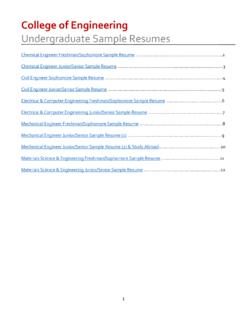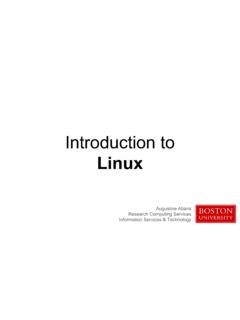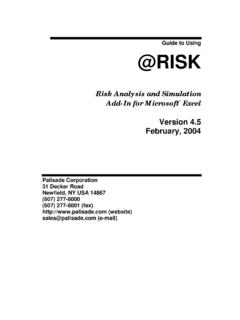Transcription of ISE 2: PROBABILITY and STATISTICS
1 ise 2 : PROBABILITY and STATISTICSL ecturerDr Emma McCoy,Room 522, Department of Mathematics, Huxley : X 48553email: Outline1. Random experiments2. PROBABILITY axioms of PROBABILITY elementary PROBABILITY results conditional PROBABILITY the law of total PROBABILITY Bayes theorem3. Systems reliability4. Discrete random variables Binomial distribution Poisson distribution5. Continuous random variables uniform distribution1 Exponential distribution Normal distribution6. Statistical Analysis Point and interval estimation7. Reliability and hazard ratesTextbooksStatistics for the engineering and computer sciences, second Mendenhall and Terry Sincich, Dellen Publishing concepts in engineering planning and design.
2 AlfredoAng and Wison Tang, Introduction Random experimentsIn general astatistical analysismay consist of: Summarization of data. Prediction. Decision making. Answering a specific question of may view a statistical analysis as attempting to separate thesignalinthe data from accompanying handout of datasets gives two examples of types of datathat we may be interested Methods of summarizing dataDataset 1We need to find a simplemodelto describe the variability that we will allow us to answer questions of interest such as: What is the PROBABILITY that 3 or more syntax errors will be present inanother module?Here the number of syntax errors is an example of adiscrete random variable it can only take one of a countable number of examples of discrete random variables include: The toss of a coin where the outcome is No of defective items found when 10 components are selected and we summarize dataset 1 in a more informative manner ?
3 Frequency Table:NUMBER OF ERRORSFREQUENCY > referring to the question of interest described above theobservedproportionof 3 or more syntax errors is This is anestimateof the true envisage an infinite number of modules this is thepopulation. We haveobtained asampleof size 30 from this population. We are really interested inthe population PROBABILITY of 3 or greater syntax are interested in finding those situations in which we can find good diagram (bar chart)A frequency diagram provides a graphical representation of the data. If weplot the proportions against number of syntax errors then we have anestimateof the PROBABILITY distribution from which the data have been 1: Frequency diagram for dataset 1 Dataset 2 Each value is a realization of what is known as acontinuous random may make is that there is no trend with time.
4 The valueschange from day to day in a way which we cannot predict again we need to findamodelfor the downloading time. For example we assume that the downloadingtimes are in general close to some value but there is some unpredictablevariability about this value which produces the day-to-day values. The waysuch variability is described is via aprobability distribution. For example we mayassume that the day-to-day values can be modelled by a PROBABILITY distributionwhich issymmetricabout . We then may wish to estimate the value of .Questions of interest here may include: What is our best guess (or estimate) of the average downloading time ?5 What sort of spread around the average value would we expect ?
5 We can summarize the data more informatively using histogram is simply a grouping of the data into a number of boxes and isanestimateof the PROBABILITY distribution from which the data allows us to understand the variability more easily for example are thedata symmetric or skewed? Are there any outlying (or extreme) observations?45678051015202530downloadin g times (seconds)Figure 2: Histogram of Dataset Summary statisticsAny quantity which is calculated from the data is known as astatistic. Statisticscan be used to summarize a given dataset. Most simple STATISTICS are measuresof either thelocationor thespreadof the 3: Normal distributionXPROBABILITY 4: A right-skewed distribution7 Suppose thatnmeasurements have been taken on the random variable underconsideration (eg number of syntax errors, downloading time).
6 Denote these measurements byx1,x2,..,xn. Sox1is the first observation,x2is the second observation, : thesample mean(or sample expected value) of the observations isgiven by:x=x1+x2+..+xnn= ni=1xin(1)For dataset 1 we havex1= 1,x2= 0, ,x30= 0andx=2430= (2)For dataset 2 we havex1= ,x2= , ,x100= : thesample medianof a sample ofnmeasurements is the middlenumber when the measurements are arranged in ascending odd then the sample median is given by measurementx(n+1) even then the sample median is given by (xn/2+x(n/2)+1) dataset 1 we have the value 0 occurring 14 times and the value 1 occurring10 times and so the median is the value 1. for data of these type the samplemedian is not such a good summary of a typical value of the dataset 2 the sample median is given by the sample average of the 50thand 51st observations.
7 In this case both of these values are and so themedian is the distribution from which the data has arisen isheavily skewed(thatis, not symmetric) then the median may be thought of as a more typical value :ExampleYearly earnings of maths graduates (in thousands of pounds):24 19 18 23 22 19 16 55 For these data the sample mean is thousand pounds whilst the samplemedian is thousand pounds. Hence the latter is a more : thesample modeis that value ofxwhich occurs with the dataset 1 the sample mode is the value the yearly earnings data the sample mode is of these sample quantities we have defined areestimatesof the corre-sponding population that for a symmetric PROBABILITY distribution the mean, the medianand the mode are the well as a measure of the location we might also want a measure of thespread of the : thesample variances2is given bys2=1n 1 ni=1(xi x) is easier to use the formula.
8 S2=1n 1[ ni=1x2i nx2]9 Thesample standard deviationsis given by the square root of the standard deviation is easier to interpret as it is on the same scale as theoriginal a measure of spread it is most appropriate to think about the standarddeviation for a symmetric distribution (such as the normal).102 ProbabilityAs we saw in Section 1 we are required to propose probabilistic models fordata. In this chapter we will look at the theory of PROBABILITY . Probabilitiesare defined upon events and so we first look at set theory and describe variousoperations that can be carried out on Set The sample spaceThe collection of all possible outcomes of an experiment is called thesamplespaceof the experiment.
9 We will denote the sample space :Dataset 1:S={0,1,2,..}Dataset 2:S={x:x 0}Toss of a coin:S={H,T}Roll of a six-sided die:S={1,2,3,4,5,6}. Relations of set theoryThe statement that a possible outcome of an experimentsis a member of S isdenoted symbolically by the an experiment has been performed and we say that someeventhasoccurred then this is shorthand for saying that the outcome of the experimentsatisfied certain conditions which specified that event. Any event can be re-garded as a certain subset of possible outcomes in the sample :roll of a die. Denote byAthe event that an even number is represented by the subsetA={2,4,6}.It is said that an eventAis contained in another eventBif every outcomethat belongs to the subset defining the eventAalso belongs to the writeA Band say thatAis a subset ofB.
10 Equivalently, ifA B, wemay say thatBcontainsAand may writeB thatA Sfor any :roll of a die, supposeAis the event of an even number being obtainedandCis the event that a number greater than 1 is obtained. ThenA={2,4,6}andC={2,3,4,5,6}andA The empty setSome events are impossible. For example when a die is rolled it is impossibleto obtain a negative number. Hence the event that a negative number will beobtained is defined by the subset ofSthat contains no outcomes. This subsetofSis called theempty setand is denoted by the symbol .Note that every set contains the empty set and so A Operations of set theoryUnionsIfAandBare any 2 events then theunionofAandBis defined to be theevent containing all outcomes that belong toAalone, toBalone or to bothAandB.













